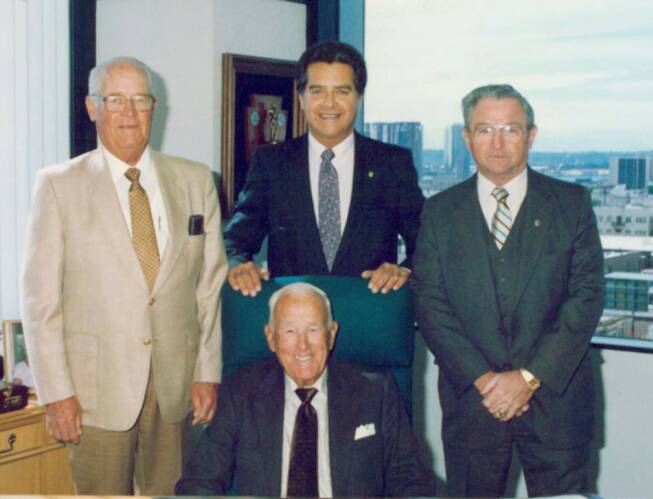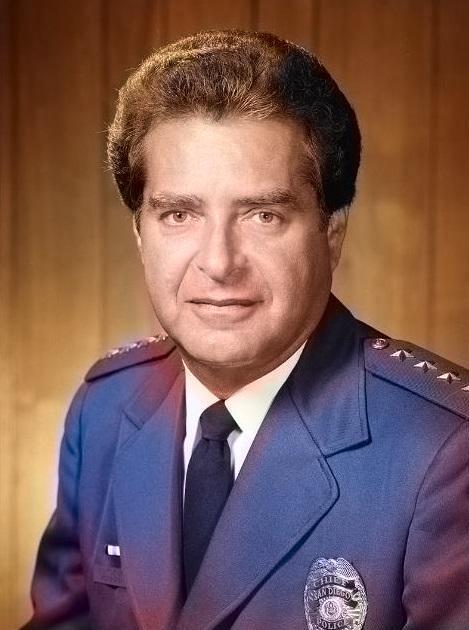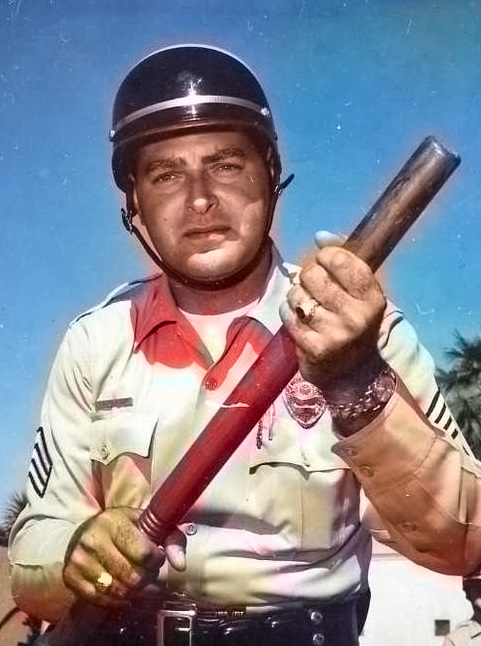
CHIEF WILLIAM B. KOLENDER (09/09/1975 - 07/29/1988)
SDPD 03/1956 - 07/29/1988
1935 - 2015
As a young man, Bill Kolender began impressing the San Diego Police Department even before his first day on the job in March 1956. It was during a final employment interview that Kolender met Chief Jansen. That night Jansen went home and told his wife, “Today I hired a young Jewish boy who is one day going to be chief of police.” Mrs. Jansen would later recall her husband never spoke of anyone like that before or after that day.
Kolender did not start out with the ambition to become a career law enforcement officer. Just out of the military, he applied to the department because a friend of his worked there and his young family needed the money. At the time Kolender was also trying to go to school to become the first member of his family to get a college degree.
Kolender’s first years on the department were spent under Sergeant Allen D. Brown.
Like that of any other new patrolman he spent the majority of his time patrolling a beat and answering radio calls. It didn’t take long though before his natural ambition took over and he found himself trying to get promoted.

1987: Chiefs Roed, Kolender, Hoobler and Sharp
1960's: Sergeant Bill Kolender
THE THIN BLUE LINE

Five years after being hired as a patrolman, he became one of the youngest sergeants ever when he was promoted at age 26.
Kolender quickly found that despite his new stripes, he still needed to keep his ego in check. He recalled one night when he had just got off shift and went to a squad party with a number of fellow officers. “I was still in my uniform with just a shirt thrown over it. The party had become a bit rowdy and some of the officers had taken to throwing each other in the swimming pool. Well here I was, a sergeant, so I said “no one had better even consider throwing me in. The next thing I knew I was looking at the party from the bottom of the pool.”
By 1965 Kolender was a lieutenant and was elected to serve as the president of the SDPOA. It was there he developed the unique skills to effectively deal with city management while at the same time not forgetting about the officers on the street. Kolender stayed at the SDPOA only two years before he took the job as a Community Relations Officer 1967.
The new job came at an especially tough time and not just for Kolender, but for police everywhere. The Watts riots of 1965 were just two years before and tensions between minority communities and police were strained across the United States.
Kolender’s approach was to listen to the community’s concerns and try and show that police and law-abiding citizens both wanted the same thing, safe neighborhoods and an orderly city. Kolender’s easy going mannerism and quick wit went a long way in establishing credibility with people who would generally consider police as their adversaries.
By 1975 Kolender was serving as the second in command under Ray Hoobler. When Hoobler resigned, it only made sense that Kolender would succeed him, yet a nationwide search was put out for the top job within the department. As the search was being conducted, Kolender served as acting chief. By September 1975 it was obvious to almost everyone that the right man for the job was already there and Kolender was officially made chief on September 10th.
Kolender wasted little time in making it known he was from a different school than previous administrations. On his first day in office he called in the command staff and announced, “I am aware of the racial and ethnic slurs and the sexist jokes that go on around here. I am also aware of how certain people are treated differently than others. I am telling you right now that if any of you do it from here on out, the first time you will be reprimanded, the next time you will be fired.” Then Inspector Bob Burgreen was at the meeting and recalled, “That was the day the SDPD went from being just another law enforcement agency into something special.”
Kolender then set about creating a department more like a family and a lot more open to diverse opinions and backgrounds. He began to promote women and minorities at a rate never before seen. His pioneering efforts would pay off years down the road when the department began to be looked at by other departments as one of the most progressive in the United States.
In the late 1970’s Kolender’s approach to crime fighting was challenged when a black man sued him for how his officers treated people in the streets.
The case of Edward Lawson began on the streets of La Jolla when he was stopped by officers and asked for identification. When Lawson couldn’t produce acceptable ID, he was arrested for violation of 647(e) of the penal code outlawing vagrancy. The arrest was not his first. Lawson had been arrested 15 times between March 1975 and January 1977. Some believed the man with the Rastafarian hairdo would purposely walk through all white neighborhoods looking for the police to stop him.
It was his last arrest that caused Lawson to file suit against the police department and the State of California asking the vagrancy statute be thrown out.
By 1982 the case had made its way before the United States Supreme Court. The high court heard arguments from both sides before issuing a ruling on May 2, 1983, that struck down the law as vague and unconstitutional. The ruling made the vagrancy law null and void throughout the state.
In 1983 Kolender authorized the establishment of the police canine program. While the program is today a huge success, with the images of 1960’s civil rights demonstrations fresh in many people’s mind, Kolender knew if the program wasn’t done correctly the positive reasons for police dogs would never be seen. One of the first points that needed to be made was that the dogs were trained for searches and assisting on arrests - they were not attack dogs.
Kolender’s 13 years as chief would be second only to Elmer Jansen for seniority. But the years had to have been much harder on him than they ever could have been on Jansen. It was during that time period he personally knocked on the doors of almost a dozen officers families to tell them their loved ones wouldn’t be coming home that night. The duty, while rough, was one Kolender accepted. As chief he owed it to them to break the news in person. “That was the chiefs job” Kolender would later comment. “I remember the first time I had to do it as chief. It was to tell Denis Allen’s wife he had been killed. I sat in the car for 45 minutes before knocking on the door. I mean, what do you say in something like that?” Kolender later said he found strength in his wife to get through those tough times.
By 1988 other employment opportunities began to look pretty attractive to Kolender. Not that there weren’t other chances before. Every San Diego mayoral election since 1976 had boosters trying to draft him to run for the city top office. This opportunity was different though. Kolender had been approached by Helen Copley, the publisher of the San Diego Union-Tribune and offered a job in top management at the newspaper. Since the job paid significantly more than that of chief, and he had always been intrigued by the media, Kolender jumped at the chance and retired after a 32-year career.
In 1994 Kolender jumped back into local law enforcement when he was elected Sheriff of San Diego County over incumbent Jim Roache. Re-elected in 1998, 2002 and 2006 his five decades of law enforcement service made him the most senior law enforcement officer in San Diego County.
Looking back at his career with the SDPD Kolender said he knew he was a success when a former employee came up to him and said, “I didn’t think you were worth a crap until you left.” The former chief said, “It was actually the best thing anyone has ever said to me.”

